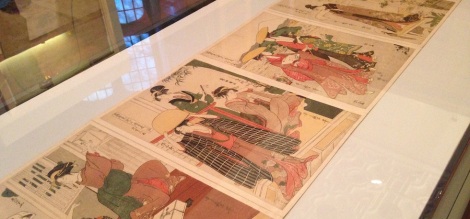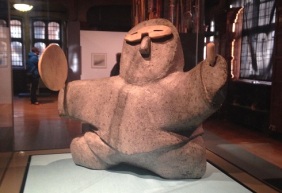Where to begin? Eight University of Cambridge Museums, objects ranging from a dodo skeleton to a Digital Optical Module of a 21st century telescope, themes of discovery and exploration, and a late Victorian mansion with hand-carved interiors. And a cafe. And a really well designed exhibition catalogue.
The theme of discovery and exploration allows for a wide range of interesting objects to be displayed and the curators have done a great job in explaining the importance of each object and why they’ve been collected and chosen for display. For instance, while the dodo skeleton needs little introduction, a beautiful wood and inlay snakes and ladders board displayed nearby is something I’ve never seen before and it turns out it is the only known example of its type, with squares depicting Sufi Islamic virtues and vices leading to the Throne of God.
Cross-cultural contact is a key theme, as European explorers came into contact with an ever wider range of people. New countries, such as Japan, opened up for trade, and other countries, such as Australia, caught the attention of explorers. New types of art and culture became valued in Europe and new collections, like Japanese prints , became common.
Modern examples of are also on display and I love the 20th/21st Century Inuit carvings, which have become a valued cultural export in recent times.
The exhibition closes with a telescope from HMS Discovery displayed next to a Digital Optical Module from an IceCube Neutrino telescope from the South Pole, which is apparently used for searching for dark matter (you can find out more here – http://icecube.wisc.edu/ if you’re so inclined) and neatly ends the exhibition’s exploration of exploration and hints at what new discoveries there are still to be made in the world.
I could have chosen any number of other objects to discuss that would have given a different flavour of the exhibition – by taking objects from eight very different museums the University of Cambridge have created a wonderfully accessible and stimulating exhibition. And I’ve not even had a chance to talk about the amazing building its housed in.
Two Temple Place, London, WC2R 3BD
http://www.twotempleplace.org/
FREE Entry
Until 27 April 2014
Closed Tuesdays





Hi Tracey, I want to start a new series on my blog, where other locals share, what their favourite place is and why. I would of course want to know, what’s your favourite museum and why. It only needs to be a short paragraph and if you dare you could write in English and German 😉 If not, I can translate, of course. Would you like to take part?
I’d love to, I’ll have a think about it. I’ll even attempt to write German but I think it will take you longer to correct it than if you translate it yourself!
That’s great! Don’t worry about the German, it’s up to you. If you come up with an idea, just send it to peggy@entdeckeengland.com A picture of either you or the museum would be nice too, if you have one. Look forward to hear from you! Peggy
Thanks for sharing this, I can’t wait to see the exhibition!
Thanks! It’s great, you’ll love it 🙂